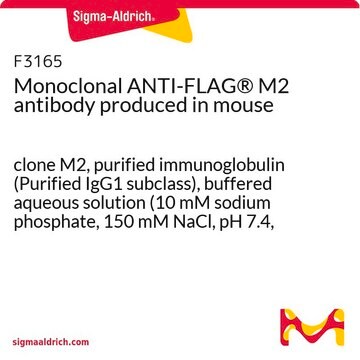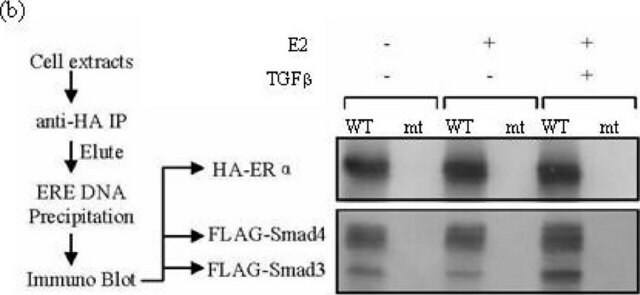11667475001
Roche
Anti-HA-Peroxidase
from mouse IgG2bκ
Sinônimo(s):
antibody
Faça loginpara ver os preços organizacionais e de contrato
About This Item
Código UNSPSC:
12352200
Produtos recomendados
fonte biológica
mouse
conjugado
peroxidase conjugate
forma do anticorpo
purified immunoglobulin
tipo de produto de anticorpo
primary antibodies
clone
12CA5, monoclonal
Ensaio
≥95% (HPLC and SDS-PAGE)
Formulário
solution
embalagem
pkg of 50 μg (500 μl)
fabricante/nome comercial
Roche
concentração
0.1 mg/mL
Isotipo
IgG2bκ
sequência de epítopo
YPYDVPDYA
temperatura de armazenamento
−20°C
Descrição geral
Anti-HA-Peroxidase is a monoclonal antibody to the HA peptide, conjugated to peroxidase. Anti-HA-Peroxidase recognizes the HA nonapeptide sequence (YPYDVPDYA), derived from the human influenza virus hemagglutinin protein (amino acids 98-106). The antibody recognizes its antigenic determinant even when the HA peptide epitope is introduced into unrelated recombinant proteins by a technique known as "epitope tagging".
Especificidade
Anti-HA-Peroxidase recognizes the 9-amino acid sequence YPYDVPDYA, derived from the human influenza hemagglutinin (HA) protein. This epitope is also recognized in fusion proteins regardless of its position (N-terminal, C-terminal or internal).
The antibody reacts with the HA epitope, a nonapeptide sequence (YPYDVPDYA) derived from the influenza hemagglutinin protein.
Imunogênio
Amino acids 98-106 from the human influenza virus hemagglutinin protein
Aplicação
- Use Anti-HA-Peroxidase for the immunochemical detection of native influenza hemagglutinin protein and recombinant HA-tagged proteins using:
- Dot blot
- Western blot
Note: For experiments in which sensitivity is not critical, use Anti-HA-Peroxidase (12CA5). For higher sensitivity detection in western blotting at 10-fold lower concentration, use Anti-HA High Affinity.
Qualidade
Each lot of Anti-HA antibody is tested for functionality and purity relative to a reference standard to confirm the quality of each new reagent preparation.
Nota de preparo
Stabilizers: BSA, sucrose, 0.02% thymol
Working concentration: Working concentration of conjugate depends on application and substrate.
The following concentrations should be taken as a guideline:
Working solution: 20-fold dilution of Western Blocking Reagent in 1x PBS.
Working concentration: Working concentration of conjugate depends on application and substrate.
The following concentrations should be taken as a guideline:
- Western blot: 0.1 μg/ml
Working solution: 20-fold dilution of Western Blocking Reagent in 1x PBS.
Outras notas
For life science research only. Not for use in diagnostic procedures.
Não está encontrando o produto certo?
Experimente o nosso Ferramenta de seleção de produtos.
Código de classe de armazenamento
12 - Non Combustible Liquids
Classe de risco de água (WGK)
WGK 1
Ponto de fulgor (°F)
does not flash
Ponto de fulgor (°C)
does not flash
Escolha uma das versões mais recentes:
Já possui este produto?
Encontre a documentação dos produtos que você adquiriu recentemente na biblioteca de documentos.
Os clientes também visualizaram
Sonia V del Rincón et al.
Oncogene, 23(57), 9269-9279 (2004-11-02)
Insulin receptor substrate-1 (IRS-1) mediates signaling from the insulin-like growth factor type-I receptor. We found that all-trans retinoic acid (RA) decreases IRS-1 protein levels in MCF-7, T47-D, and ZR75.1 breast cancer cells, which are growth arrested by RA, but not
Asvin K K Lakkaraju et al.
Molecular biology of the cell, 23(14), 2712-2722 (2012-06-01)
Mammalian cells secrete a large number of small proteins, but their mode of translocation into the endoplasmic reticulum is not fully understood. Cotranslational translocation was expected to be inefficient due to the small time window for signal sequence recognition by
Marta García-León et al.
The Plant cell, 31(10), 2411-2429 (2019-08-01)
The plant endosomal trafficking pathway controls the abundance of membrane-associated soluble proteins, as shown for abscisic acid (ABA) receptors of the PYRABACTIN RESISTANCE1/PYR1-LIKE/REGULATORY COMPONENTS OF ABA RECEPTORS (PYR/PYL/RCAR) family. ABA receptor targeting for vacuolar degradation occurs through the late endosome
Ryan M Drenan et al.
The Journal of biological chemistry, 281(38), 28222-28231 (2006-07-27)
The RGS7 (R7) family of G protein regulators, Gbeta5, and R7BP form heterotrimeric complexes that potently regulate the kinetics of G protein-coupled receptor signaling. Reversible palmitoylation of R7BP regulates plasma membrane/nuclear shuttling of R7*Gbeta5*R7BP heterotrimers. Here we have investigated mechanisms
Helen Wedegaertner et al.
Molecular biology of the cell, 34(9), ar93-ar93 (2023-05-24)
The α-arrestin ARRDC3 is a recently discovered tumor suppressor in invasive breast cancer that functions as a multifaceted adaptor protein to control protein trafficking and cellular signaling. However, the molecular mechanisms that control ARRDC3 function are unknown. Other arrestins are
Nossa equipe de cientistas tem experiência em todas as áreas de pesquisa, incluindo Life Sciences, ciência de materiais, síntese química, cromatografia, química analítica e muitas outras.
Entre em contato com a assistência técnica












